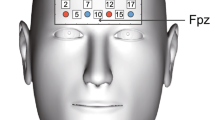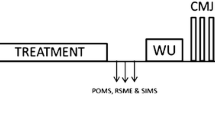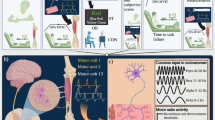Abstract
The purpose of this investigation was to evaluate the efficacy of a dissociative cognitive strategy in facilitation of endurance performance. A pilot study of endurance performance was conducted in which 15 subjects ran to exhaustion on a motor-driven treadmill at 80% of maximal aerobic power (MAP). These subjects were randomly assigned to a cognitive strategy (dissociation), placebo, or control group and retested. The group employing the cognitive strategy was superior (+19%) to the control and placebo groups. In the second experiment control (N = 13) and dissociation (N = 14) groups were tested at 80% of MAP under baseline conditions, and again at the same metabolic demand with the exception that subjects in the experimental group employed the dissociative cognitive strategy used in the pilot study. The two groups were found to be remarkably similar on all physiological measures, but the dissociation group experienced a significant performance gain. The exercise metabolite, blood lactate, was similar in the two groups, and plasma catecholamine levels were higher in the dissociation group. This implies that distraction of sensory discomfort enabled subjects in the dissociation group to tolerate a greater amount of discomfort for a longer period of time. These findings suggest that a cognitive strategy based upon dissociation of sensory input can facilitate endurance performance on tasks of the type employed in the current investigation.
Similar content being viewed by others
Reference Note
Arnett, A. J.The influence of contingent reinforcement on heart rate during exercise. Master's thesis, University of Wisconsin-Madison, 1974.
References
Åstrand, P. O., & Rodahl, K.Textbook of work physiology (1st ed.). New York: McGraw-Hill, 1970.
Benson, H., Dryer, T., & Hartley, H. Decreased V02 consumption during exercise with elicitation of the relaxation response.Journal of Human Stress 1978,4 38–42.
Borg, G. A. V. Perceived exertion: A note on “history” and methods.Medicine and Science in Sports 1973,5 90–93.
Cavanagh, P. R., Pollock, M. L., & Landa, J. A biomechanical comparison of elite and good distance runners.Annals of the New York Academy of Sciences 1977,301 328–345.
Griffiths, J., Leung, F., & McDonald, T. J. Fluorometric determinations of plasma catecholamines: Normal human epinephrine and norepinephrine values.Clinical Chemistry Acta 1970,30 395–405.
Horstman, D. H., Morgan, W. P., Cymerman, A., & Stokes, J. Perception of effort during constant work to self-imposed exhaustion.Perceptual and Motor Skills 1979,48 1111–1126.
Klissouras, V. Heritability of adaptive variation.Journal of Applied Physiology 1971,31 338–344.
Morgan, W. P., Hirota, K., Weitz, G. A., & Balke, B. Hypnotic perturbation of perceived exertion: Ventilatory consequences.American Journal of Clinical Hypnosis 1976,18 182–190.
Morgan, W. P., Horstman, D. H., Cymerman, A., & Stokes, J. Exercise as a relaxation technique.Primary Cardiology 1980,6 48–57.
Morgan, W. P., & Pollock, M. L. Psychologic characterization of the elite distance runner.Annals of the New York Academy of Sciences 1977,301 382–403.
Morgan, W. P., Raven, P. B., Drinkwater, B. L., & Horvath, S. M. Perceptual and metabolic responsivity to standard bicycle ergometry following various hypnotic suggestions.International Journal of Clinical and Experimental Hypnosis 1973,21 86–101.
Nagle, F. J. Physiological assessment of maximal performance. In J. H. Wilmore (Ed.),Exercise and sport science reviews. New York: Academic Press, 1973. Pp. 313–338.
Pandolf, K. B. Influences of local and central factors in dominating rated perceived exertion during physical work.Perceptual and Motor Skills 1978,46 683–698.
Spielberger, C. D., Gorsuch, R. L., & Lushene, R. E.The State-Trait Anxiety Inventory Manual. Palo Alto: Consulting Psychologists Press, 1969.
Wilmore, J. H. Influence of motivation on physical work capacity and performance.Journal of Applied Physiology 1968,24 459–463.
Author information
Authors and Affiliations
Additional information
The views, opinions and/or findings contained in this report are those of the author(s) and should not be construed as an official Department of the Army position, policy, or decision, unless so designated by other official documentation. Human subjects participated in these studies after giving their free and informed consent. Investigators adhered to AR 70-25 and USAMRDC Regulation 70-25 on Use of Volunteers in Research.
Rights and permissions
About this article
Cite this article
Morgan, W.P., Horstman, D.H., Cymerman, A. et al. Facilitation of physical performance by means of a cognitive strategy. Cogn Ther Res 7, 251–264 (1983). https://doi.org/10.1007/BF01205139
Issue Date:
DOI: https://doi.org/10.1007/BF01205139




